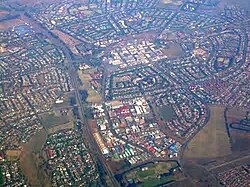Vanderbijlpark
| Vanderbijlpark | |
|---|---|
 |
|
|
|
|
| Coordinates: 26°41′57″S 27°50′8″E / 26.69917°S 27.83556°ECoordinates: 26°41′57″S 27°50′8″E / 26.69917°S 27.83556°E | |
| Country | South Africa |
| Province | Gauteng |
| District | Sedibeng |
| Municipality | Emfuleni |
| Established | 1949 |
| Area | |
| • Total | 177.84 km2 (68.66 sq mi) |
| Population (2011) | |
| • Total | 95,840 |
| • Density | 540/km2 (1,400/sq mi) |
| Racial makeup (2011) | |
| • Black African | 42.5% |
| • Coloured | 1.3% |
| • Indian/Asian | 0.9% |
| • White | 54.4% |
| • Other | 0.9% |
| First languages (2011) | |
| • Afrikaans | 51.0% |
| • Sotho | 19.9% |
| • English | 10.0% |
| • Zulu | 4.9% |
| • Other | 14.2% |
| Postal code (street) | 1911 |
| PO box | 1900 |
| Area code | 016 |
Vanderbijlpark is an industrial city with 95 000 inhabitants on the Vaal River in the south of the Gauteng province of South Africa.
Named after Hendrik van der Bijl, an electrical engineer and industrialist, Vanderbijlpark is home to Vanderbijlpark Steel (previously part of ISCOR (South African Iron and Steel Corporation), now part of the global company ArcelorMittal). With neighbouring towns Vereeniging and Sasolburg it forms the Vaal Triangle, a major industrial region of South Africa. Located in the district municipality of Sedibeng and the local municipality of Emfuleni.
The historical black townships Boipatong, Bophelong, Sebokeng, Evaton and Sharpeville are close to the city.
Vanderbijlpark is also home to Cape Gate (Pty) Ltd, a major market share holder in the wire industry.
In 1920, Dr HJ van der Bijl, a young South African electrical engineer working in the United States at the time, was called back to South Africa by the then Prime Minister Jan Smuts to advise the government in the planning of South Africa's industrial development. Van der Bijl oversaw the Iron and Steel Corporation's first plant at Pretoria, but with the increased demand after World War II, 100 km² was bought to build a large steel works and model town. The steel works began operating in 1947 and the town was proclaimed in 1949. The town attained municipal status in 1952 when Governor General Dr EG Jansen opened ISCOR's second steel works. The founder of the town, Hendrik van der Bijl, had his old house situated in Grieg street, in the affluent SW 5 proper suburb.
...
Wikipedia



